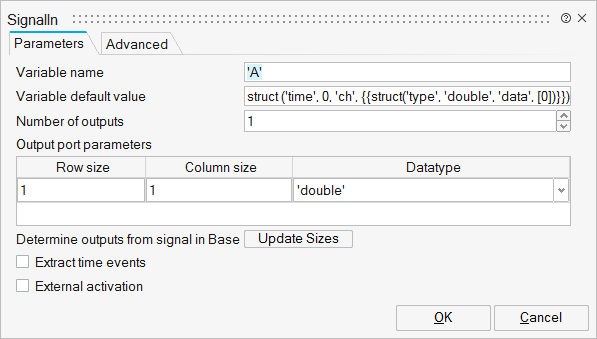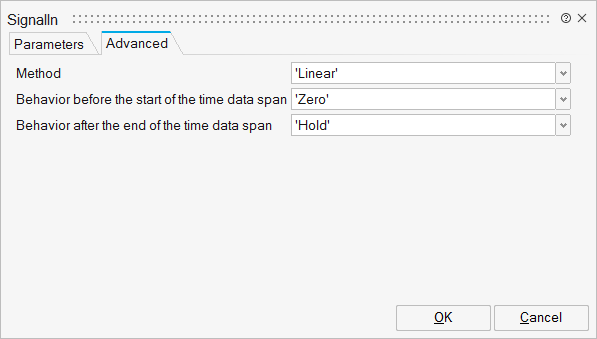SignalIn
This block takes variables defined in the OML workspace and treats them as signals. The variable should have "time" and "ch" fields.
![]()
Library
SignalImporters
Description
This block is used to get variables defined in the OML workspace and use them in Activate.
The variable can be defined either in the OML shell or by a SignalOut block.
For example, the following OML command creates a variable B:
B=struct ("time", [0,1,3], "ch", {{struct("type", "double", "data", [2,5,3])}})
The Variable B defines the value of a signal at three instants 0, 1, and 3. A variable can be of any datatype supported by Activate.
A SignalOut block is usually used to create a variable acceptable by the SignalIn block. The SignalIn block can reconstruct the original signal fed to the SignalOut block in another model or simulation.
The variable provides the values of a signal V(i), at different time instants T(i). The value of the signal at times other than elements of T(i) are computed via interpolation or extrapolation. Several interpolation methods are available:"ZeroOrder", "Linear", "Not_a_knot", "Natural", and "Clamped_To_Zero".
"ZeroOrder": The element in T(i) which is the nearest and below the current time is gievn at the output, i.e.,
"Linear". This is the default method and performs a linear interpolation. If the time matches one of T elements, the output is the corresponding element in the V matrix. If no value matches the block's input, then the block performs linear interpolation between the two appropriate elements of the table to determine the output value, i.e.,
"Not_a_knot": A cubic spline is computed and used by imposing the following conditions (considering N points T(1),...,T(N)) :
"Natural": A cubic spline is computed and used by imposing the following conditions (considering N points T(1),...,T(N)) :
"Clamped_To_Zero": A cubic spline is computed and used by imposing the following conditions (considering N points T(1),...,T(N)) :
The value of the signal at time instants out of the range [T(1), T(N)] are computed via extrapolation. Several extrapolation methods are available: "Zero", "Hold", "Extrapolation", and "Repeat".
"Zero":This is the default method. In this case, the output is zero for time instants out of signal's range, i.e.,
"Hold": The output is equal to the last element of the V vector, i.e.,
"Extrapolation". The block performs linear extrapolation using two last elements of the signal, i.e.,
"Repeat". The signal is repeated over the whole range.
The variable should have "time" (time instants vector) and "ch" (channels) fields and the "ch" field should have "type" (datatype) and "data" (data values) fields.
If the variable is not defined in the OML workspace, the default value of the variable is used instead. The default value is a parameter of the block.
Parameters

| Name | Label | Description | Data Type | Valid Values |
|---|---|---|---|---|
varnam | Variable name | Name of the variable in the OML workspace. | String | |
defvalue | Variable default value | Value used in case the variable is not defined in the OML workspace. | ||
nout | Number of outputs | Number of outputs, equal to the number of channels in the cell "ch". | Number | |
outports | Output port parameters | Structure | ||
outports/outrow | Row size | Cell of scalars | ||
outports/outcol | Column size | Cell of scalars | ||
outports/ot | Datatype | Cell of strings | 'double' | |
outevent | Extract time events | This parameter defines if the block generates an activation event. When OutEvent is used, a additional event output port is added to the block. default is OFF. | Scalar | 0 |
externalActivation | External activation | This parameter defines if the block receives an external activation or inherits. When External Activation is used, a additional activation port is added to the block. default is OFF. | Number | 0 |

| Name | Label | Description | Data Type | Valid Values |
|---|---|---|---|---|
Method | Method | String | 'ZeroOrder' | |
Leftside | Behavior before the start of the time data span | String | 'Zero' | |
Rightside | Behavior after the end of the time data span | String | 'Zero' |
Ports
| Name | Type | Description | IO Type | Number |
|---|---|---|---|---|
Port 1 | explicit | Output variable value. | output | nout |
Port 2 | activation | External activation signal. If the block is activated by ths port, the time vector of the workspace signal is ignored. | input | externalActivation |
Port 3 | activation | If this port is displayed, it generates events at time instants of the vector T(i). This event is generated if ZeroOrder and Linear interpolation methods are chosen. | output | outevent |
Advanced Properties
| Name | Value | Description |
|---|---|---|
always active | no | Time Dependency = standard mode activated |
direct-feedthrough | no | |
zero-crossing | no | |
mode | no | |
continuous-time state | no | |
discrete-time state | no |